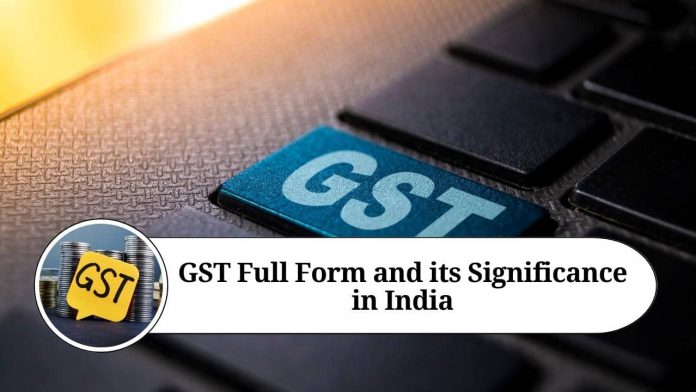What is GST?
GST stands for Goods and Services Tax, which is an indirect tax imposed in India on the supply of goods and services. It was introduced in July 2017 and has replaced several indirect taxes levied by the Central and State governments.
GST is a comprehensive tax system that subsumes most of the indirect taxes into one single tax.
GST Full Form Explained
GST full form stands for Goods and Services Tax, which is an indirect tax imposed on the supply of goods and services in India. This tax is levied at every stage of the supply chain, from the manufacturer to the consumer. The GST collected at each stage is credited to the government, which reduces the cascading effect of taxes on the final consumer.
GST in India
GST has been implemented in India as a comprehensive indirect tax system to subsume several indirect taxes into one single tax. The GST system in India has two main components, the Central GST (CGST) and the State GST (SGST), which are levied by the Central and State governments, respectively.
Read Other Useful Blogs:
The GST system in India has been implemented as a dual GST system, where both the Central and State governments have the power to levy and collect taxes on the supply of goods and services.
Benefits of GST
The implementation of GST has brought several benefits to the Indian economy. Some of the key benefits of GST are:
- Simplification of the tax structure: GST has simplified the indirect tax structure in India by subsuming several indirect taxes into one single tax.
- Reduction of cascading effect of taxes: GST has reduced the cascading effect of taxes on the final consumer by allowing for the credit of taxes paid at each stage of the supply chain.
- Increased transparency: GST has increased transparency in the tax system by providing a seamless flow of input tax credits and reducing the scope for tax evasion.
- Boost to the Indian economy: GST has provided a boost to the Indian economy by increasing the tax base, reducing the cost of goods and services, and promoting economic growth.
How does GST work?
GST works on the principle of a value-added tax, where tax is levied at each stage of the supply chain, from the manufacturer to the consumer. The GST collected at each stage is credited to the government, which reduces the cascading effect of taxes on the final consumer.
The GST system in India has two main components, the Central GST (CGST) and the State GST (SGST), which are levied by the Central and State governments, respectively.
Read Other Useful Blogs:
GST Rates
The GST council, which is composed of the Finance Ministers of the Central and State governments, determines the GST rates in India. There are five GST rates in India, which are 0%, 5%, 12%, 18% and 28%. Essential goods and services, such as food and healthcare, are taxed at a lower rate, while luxury goods and services are taxed at a higher rate.
GST Returns
Under the GST system, taxpayers are required to file regular returns, which are used to determine their GST liability. The returns filed by taxpayers under the GST system include the details of their taxable supplies, input tax credits, and GST paid during the relevant tax period. GST returns can be filed online through the GST portal, which makes the process of filing returns simple and convenient.
GST Compliance
GST compliance is a critical aspect of the GST system in India, as it helps to ensure that taxpayers comply with the provisions of the GST Act and regulations. GST compliance involves several activities, such as registering for GST, obtaining GSTIN, filing regular returns, and making timely payments of GST. The GST council has introduced several measures to encourage GST compliance, such as the GST composition scheme, which allows small taxpayers to pay GST at a lower rate and file returns on a quarterly basis.
Challenges faced by taxpayers under the GST system
Despite the benefits of the GST system, there have been several challenges faced by taxpayers, which have impacted their ability to comply with the provisions of the GST Act and regulations. Some of the challenges faced by taxpayers under the GST system include:
- Complexity of the GST laws and regulations: The GST laws and regulations in India are complex and difficult to understand, which has made it challenging for taxpayers to comply with the provisions of the GST Act and regulations.
- Lack of awareness about GST: There is a lack of awareness about GST among taxpayers, which has made it difficult for them to understand the provisions of the GST Act and regulations.
- Technical glitches in the GST portal: Technical glitches in the GST portal have made it difficult for taxpayers to file returns and make payments of GST, which has impacted their ability to comply with the provisions of the GST Act and regulations.
- Inadequate support from the GST council: Taxpayers have also expressed dissatisfaction with the support provided by the GST council, which has made it difficult for them to comply with the provisions of the GST Act and regulations.
Conclusion
GST full form stands for Goods and Services Tax, which is an indirect tax imposed in India on the supply of goods and services. The GST system in India has been implemented as a comprehensive indirect tax system to subsume several indirect taxes into one single tax.
The implementation of GST has brought several benefits to the Indian economy, including simplification of the tax structure, reduction of cascading effect of taxes, increased transparency, and a boost to the economy.
Despite the benefits of the GST system, there have been several challenges faced by taxpayers, including the complexity of the GST laws and regulations, lack of awareness about GST, technical glitches in the GST portal, and inadequate support from the GST council.
The GST council must address these challenges and provide support to taxpayers to help them comply with the provisions of the GST Act and regulations.
Frequently Asked Questions (FAQs)
- What is GST?
GST stands for Goods and Services Tax, which is a comprehensive indirect tax system in India that subsumes several indirect taxes into one single tax.
- Who administers GST in India?
GST is administered by both the Central and State governments in India. The Central GST (CGST) is levied by the Central government, while the State GST (SGST) is levied by the State governments.
- What are the GST rates in India?
There are five GST rates in India, which are 0%, 5%, 12%, 18% and 28%. Essential goods and services are taxed at a lower rate, while luxury goods and services are taxed at a higher rate.
- Who needs to register for GST in India?
All entities engaged in the supply of goods and services with an annual turnover of more than 20 lakhs (10 lakhs for North Eastern and hill states) are required to register for GST in India.
- How does GST work in India?
GST works on the principle of a value-added tax, where tax is levied at each stage of the supply chain, from the manufacturer to the consumer. The GST collected at each stage is credited to the government, reducing the cascading effect of taxes on the final consumer.
- What are the GST returns that need to be filed in India?
GST returns that need to be filed in India include the details of taxable supplies, input tax credits, and GST paid during the relevant tax period. GST returns can be filed online through the GST portal.
- What is GST compliance in India?
GST compliance involves several activities, such as registering for GST, obtaining GSTIN, filing regular returns, and making timely payments of GST.
- What are the challenges faced by taxpayers under the GST system in India?
The challenges faced by taxpayers under the GST system in India include complexity of the GST laws and regulations, lack of awareness about GST, technical glitches in the GST portal, and inadequate support from the GST council.
- How has GST impacted the Indian economy?
GST has brought several benefits to the Indian economy, including simplification of the tax structure, reduction of cascading effect of taxes, increased transparency, and a boost to the economy.
- What support is available for taxpayers to comply with the provisions of the GST Act and regulations in India?
The GST council provides support to taxpayers to help them comply with the provisions of the GST Act and regulations. Taxpayers can also seek assistance from GST practitioners and consultants to help them comply with the provisions of the GST Act and regulations.





















Seriously very good contribution, I really depend on up-dates of your stuff.
Aw, this was a very nice post. In idea I wish to put in writing like this additionally – taking time and precise effort to make a very good article… however what can I say… I procrastinate alot and in no way seem to get one thing done.
extremely good post, i certainly enjoy this site, keep on it
When I originally commented I clicked the -Notify me when new comments are added- checkbox and now every time a comment is added I get four emails with the same comment. Is there any way you can get rid of me from that service? Thanks!
of course data entry services are very expensive that is why always make a backup of your files
This is great content! I am swept away by your presentation and unique viewpoints. I agree with so much of your article. I’ll come back.